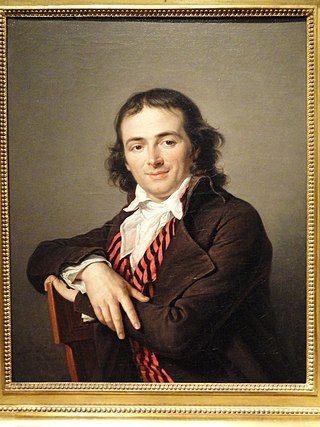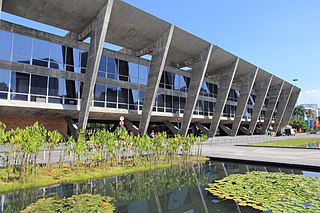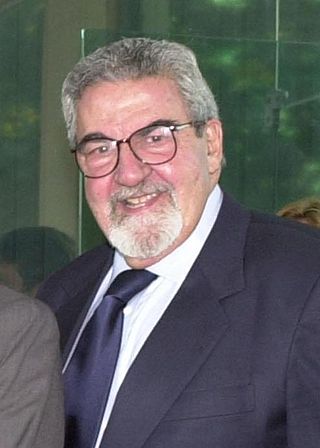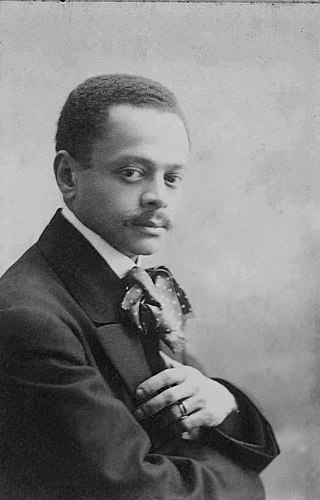
Oscar Ribeiro de Almeida Niemeyer Soares Filho, known as Oscar Niemeyer, was a Brazilian architect considered to be one of the key figures in the development of modern architecture. Niemeyer was best known for his design of civic buildings for Brasília, a planned city that became Brazil's capital in 1960, as well as his collaboration with other architects on the headquarters of the United Nations in New York. His exploration of the aesthetic possibilities of reinforced concrete was highly influential in the late 20th and early 21st centuries.

Lúcio Marçal Ferreira Ribeiro Lima Costa was a Brazilian architect and urban planner, best known for his plan for Brasília.

The French Artistic Mission in Brazil was a group of French artists and architects that came to Rio de Janeiro, then the capital city of the United Kingdom of Portugal, Brazil and the Algarves, in March 1816, under the auspices of the royal court of Portugal, which had been transferred to Brazil since 1808 due to Portugal's invasion by Napoleon Bonaparte. The Mission, led by Joachim Lebreton, had the mission of establishing the Escola Real de Ciências, Artes e Ofícios, which later became the Escola Nacional de Belas Artes.

The Museu Nacional de Belas Artes is a national art museum located in the city of Rio de Janeiro, Brazil. The museum, officially established in 1937 by the initiative of education minister Gustavo Capanema, was inaugurated in 1938 by President Getúlio Vargas. The museum collection, on the other hand, takes its rise in the transfer of the Portuguese Court to Brazil in the early 19th century, when King John VI brought along with him part of the Portuguese Royal Collection. This art collection stayed in Brazil after the King's return to Europe and became the core collection of the National School of Fine Arts. When the museum was created in 1937, it became the heir not only the National School collection, but also of its headquarters, a 1908 eclectic style building projected by Spanish architect Adolfo Morales de los Ríos.

The Gustavo Capanema Palace, also known architecturally as the Ministry of Education and Health Building, is a government office building in the Centro district of Rio de Janeiro, Brazil. As the first modernist project in Brazil, it is historically important to the architectural development of Modernism in Brazil and has been placed on Brazil's UNESCO tentative list.

Flamengo Park, also known as Aterro do Flamengo, Eduardo Gomes Park, and Aterro do Brigadeiro Eduardo Gomes, is the largest public park and recreation area within the city of Rio de Janeiro, in eastern Brazil, and the largest urban seaside park in the world.

Escola de Belas Artes is one of the centers of the Federal University of Rio de Janeiro and dates back to colonial times.

Georgina de Albuquerque was a Brazilian Impressionist painter and teacher. She was known for her interest in female subjects. Her husband Lucílio was a noted painter in his own right and the two are strongly associated with each other.

Rodolfo Amoedo was a Brazilian painter, designer and decorator.

Eliseu Visconti, born Eliseo d'Angelo Visconti was an Italian-born Brazilian painter, cartoonist, and teacher. He is considered one of the very few impressionist painters of Brazil. He is considered the initiator of the art nouveau in Brazil.

Carlota de Camargo Nascimento (Loty) (October 7, 1904 – July 2, 1974) was a Brazilian sculptor and poet. She signed her works as Loty. Loty was one of the first female sculptors in Brazil.

The Museum of Modern Art of Rio de Janeiro is a museum located in northeastern Flamengo Park, in the city of Rio de Janeiro, Brazil. It is in the Centro district, west of Santos Dumont Airport, on Guanabara Bay.

Luiz Paulo Fernández Conde was a Brazilian architect and politician. He was Mayor of Rio de Janeiro from 1997 to 2001 and Vice Governor from 2003 to 2007.

Arthur Timótheo da Costa was an Afro-Brazilian painter and designer.

The Pedregulho Housing Complex is an apartment complex and planned community in the Benfica neighborhood of Rio de Janeiro, Brazil. It was designed by the architect Affonso Eduardo Reidy (1909-1964). The project was planned in 1946 to house lower-paid civil servants of the city, which was then the Federal District of Brazil. Work commenced on the complex in 1949 and inaugurated in 1951/1952.

João Timóteo da Costa was an Afro-Brazilian painter and decorative artist.

Augusto Bracet was a Brazilian painter, drawer and professor.

Carmen Velasco Portinho (1903–2001) was a Brazilian civil engineer, urbanist, and feminist. A pioneering woman in her field, Portinho was the third woman to graduate as an engineer in Brazil.
Hélio Uchôa Cavalcanti (1919–1971) was a Brazilian architect who contributed significantly to Brazilian national architecture and its modernist renewal. He collaborated with Oscar Niemeyer on projects like Rio de Janeiro's Lagoa Hospital and São Paulo's Ibirapuera Park, contributed to Brasilia's construction, and designed various residences and hotels globally.




















